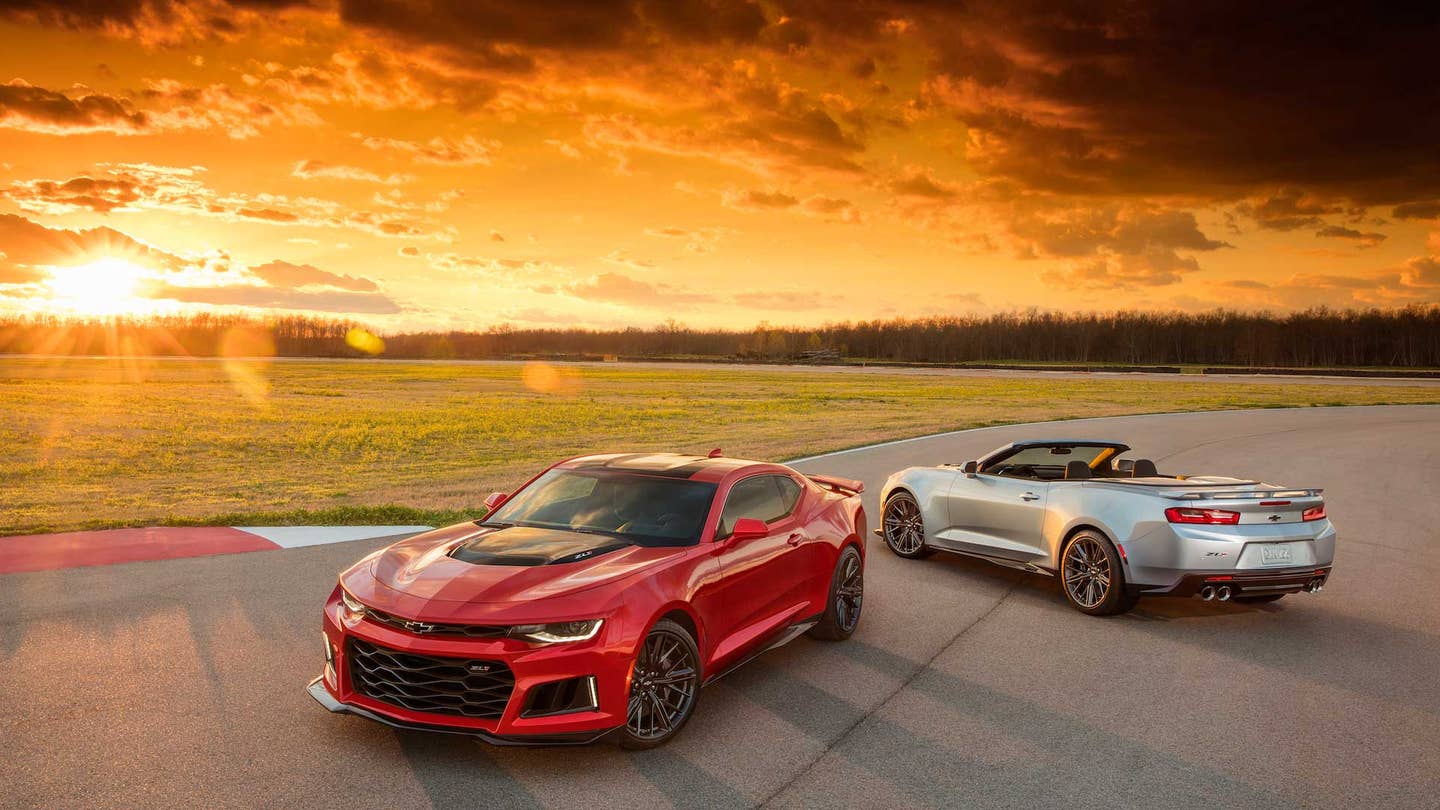How the Chevy Camaro ZL1 Will Slay Ford’s Mustang Shelby GT350R
Al Oppenheiser, the Camaro’s chief engineer, lays out his battle plans.

That sound you hear? It’s the Chevrolet Camaro ZL1, almost surely blowing past the Ford Mustang Shelby GT350R, perhaps even making the Corvette Z06 a bit nervous. Also: supercharger whine. This one’s a howitzer, kids.
Chevrolet had cited 640 horsepower and an identical torque output for the ZL1 coupe and convertible, the latter revealed Thursday at New York’s auto show. But Al Oppenheiser, the Camaro’s chief engineer, suggested that already-heady horsepower rating could rise by the time the ZL1’s go on sale late this year. Wouldn’t, say, 650 ponies be an affront to the Z06, matching the output of the Corvette using the same supercharged, 6.2-liter LT4 V8? Not so, Oppenheiser says.
“We don’t have any mantras," Oppenheiser says, nothing to forbid the Camaro from stepping on the Corvette’s toes or territory.
Regarding stepping (stomping?), the ZL1 still isn’t as movie-star handsome as Ford’s Shelby. But it’s hard to see the 526-horsepower Shelby keeping pace with the blown Camaro, from power and straight-line performance to technology and track lap times.
Let’s review. The previous generation Camaro ZL1 (581 hp, 220 heavier, sadeled with a six-speed auto) ran the quarter-mile in 12 seconds flat. That’s already as quick, or a touch quicker, than the Shelby GT350R. The new generation Camaro SS coupe gets to 60 mph in four seconds, just one-tenth behind the GT350R. And that Camaro SS only has 455 horsepower.
So Oppenheiser invites us to imagine how fast his Camaro ZL1 will be: 640 horses, a lightened body and the industry’s first 10-speed automatic transmission. We’d figure a 3.5-second bolt to 60 mph, and an 11.5-second quarter-mile at, maybe, 126 mph. The Shelby will hit the quarter-mile at least a half-second later (at 12 to 12.2 seconds, depending on the tester) traveling at about 119 mph.
“I can’t wait ‘til you drive the 10 speed,” Oppenheiser enthuses, saying the ZL1 never seems to run out of torque or gears. “It’s a beast anyway, but it makes the car feel like a Fast and Furious movie.”
Numbers-crunchers will still count to 707 to reach the power apogee that is the Dodge Challenger and Charger Hellcats. We love the Hellcats in all their improbable glory, but let’s get real. It’s hard enough to get all those Mopar horses to the ground in a straight line; on the racetracks or a two-lane, the uber-agile ZL1 will sink the Hellcats like the two-ton schooners they are.
The convertible, for its part, will address the Camaro’s most shameful ergonomic slip-up, at least in al frescoweather: severely constricted outward visibility. That pleasure, along with the new convertible’s roofline—which more closely matches the cop-chase sweep of the coupe’s—will cost you maybe 150 pounds of extra weight. And where the ZL1 coupe adopts the Corvette’s Performance Data Recorder and brilliant electronic limited-slip differential, with additional track-oriented modes compared with civilian-issue Camaros, the convertible makes do with a mechanical rear diff. That’s due to space constraints created by its additional structure to prevent any top-down jitters.
Even aside from ZL1 techno goodies, including the Alpha platform (shared with Cadillac ATS-V and CTS-V) and magnetic suspension, Oppenheiser is proud of new Recaro sport seats. Engineers, noticing the seats sometimes caught elbows and disrupted smooth manual shifting on tracks, reworked the side bolsters to ensure there’d be no interference.
And no Camaro discussion is complete without mentioning the 9 million hours of computer analysis that went into the full Camaro lineup (including an eventual Z/28, we’re hoping) with simulations running “multiple models, all night and everyday.” As opposed to driving prototypes until they break, then racing back to rework or add parts—and creating expensive delays in doing so—engineers could modify the Camaro’s digital design before any tooling was created, saving time, money and manpower.
“If you’re not building 100 prototypes at a half million dollars each, you don’t have to pass those costs to customers for parts you can’t even see.”
At the starter end of the lineup, the turbocharged four-cylinder Camaro is just reaching customers. And with the first convertible Camaros ready to ship, Chevy will finally have the full lineup to take on Ford’s Mustang in the obsessively-watched pony car sales stampede.
“We’re already closing the gap, and we’re confident we’re going to overtake them,” Oppenheiser says.
Ah, poor Mustang Shelby. It seemed only yesterday that you were the fastest pony car in town.
